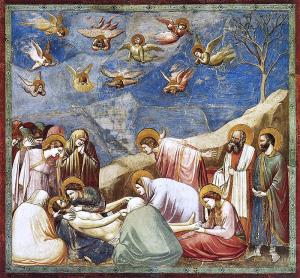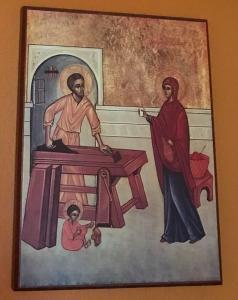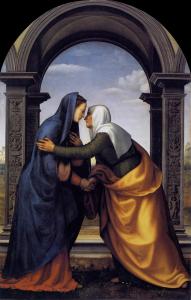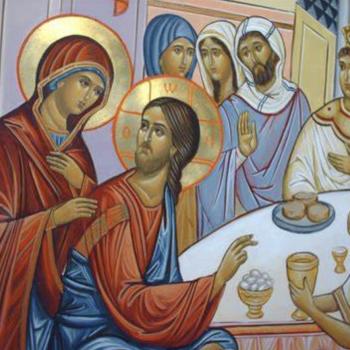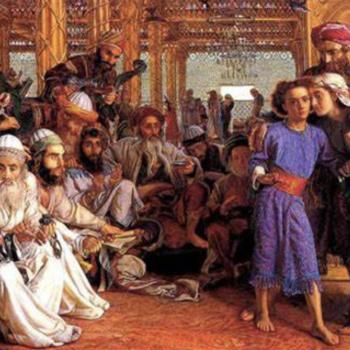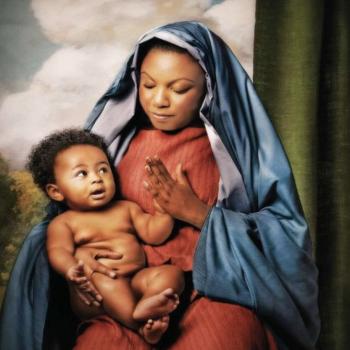It’s June! The grass is green, the robins are feeding their babies in the nest outside my window, and we’re talking about things that kept us alive in May.
Specifically, we’re talking about Mary.
Marian devotion can be complicated. Mary can seem remote, even though she is a figure who invites us to draw closer to the divine. Mary can seem anachronistic. Lingering Victorian sensibilities can make Mary seem like a feminine type that is oppressive, or even antithetical, to the realities of being a woman. Some of us may have had bad experiences with Marian devotion that make Mary seem like someone to be feared, and not like someone who loves us.
And, of course, a devotion that is inviting to one person may be thoroughly off-putting to another (ahem, St. Louis de Montfort, I’m looking at you).
In the spirit of Things Keeping Us Alive, we at Sick Pilgrim are talking about Marian things that keep us alive: our own particular ways of thinking about Mary, our peculiar devotions, and favorite images.
For me, one of the most compelling images of Mary was painted by Giotto and is found in the Scrovegni Chapel. Mary is so often shown to be completely serene. When she’s being visited by an angel, when she’s telling Christ what to do at the wedding at Cana, when she’s being assumed into heaven – she’s nearly always looks as though she’s in command of the situation.
In Giotto’s Lamentation of Christ, Mary is not serene. Her face is full of emotion, and she is grieving. She looks real. She looks like someone who is, maybe, kind of intense. She is no stranger to strong emotion. It’s an image that disrupts the sense that I can only be like Mary if I negate any kind of inner intensity.
Another quasi-Marian devotion I have is the movie Moonstruck. Bear with me here. (And notice that I’m pinch hitting for Matt LaFleur this month, who is probably not as enthusiastic about the movie Moonstruck as I am.)
It occurred to me recently that Mary is reflected in a number of female character in Moonstruck.
She’s the lady in the convenience store who has seen a wolf in everyone she’s ever met, and she sees the wolf in you.
She’s Cher’s character, knowing the real reasons why we do the crazy things we do, and telling us to snap out of it.
She’s Olympia Dukakis, who does not sin because she knows who she is.
She knows that we sin because we fear death.
And she reminds us that our lives are not built on nothing – because she loves us.
Marybeth Chuey Bishop lives in Annapolis with her husband and children, two dogs, and some scruffy plants. She likes to walk, wear socks with kraken or Poe on them, and write with her blogging partner-in-crime Kristen at Crone Café. You can find them on Facebook or at cronecafe.wordpress.com.
I’ve already written about the statue of Mary that I inherited from my parents, which is probably my very favorite physical Marian item since it holds so many memories of my family. A close second would be this icon of the Holy Family. I love how they are depicted doing very ordinary things with love—Joseph is pausing in his work; Mary is bringing him a drink of water; Jesus is playing at their feet. There’s nothing flashy here, just a family serving God by doing their work and loving each other.
The other Marian devotion that is special to me is Mary’s relationship with her cousin Elizabeth. I like to think of too-young-for-this Mary learning the ropes of pregnancy, labor, delivery, and those first fragile days of motherhood from too-old-for-this Elizabeth. We know they prayed together. I hope they laughed together. They almost certainly cried together, held each other’s hands, maybe even braided each other’s hair. I’d love to sit in the presence of these two strong, holy women as they learn from each other and just enjoy one another’s company.
John Farrell is a freelance writer from the Boston area, who writes with a particular focus on the history of science, and science and religion. He also writes short stories and has been known to publish an occasional poem.
I like to think of Mary (or Miriam, as she would have been known in Hebrew) as delightfully–odd. As someone who already perhaps had a reputation in a very small village. A reputation for being…strange. And far from being unattractive–she was striking, but in an unusual –very un-iconic way. Perhaps her eyes were considered too deep set over a nose some thought too prominent–and yet she could disarm people by an unwavering gaze–something her parents insisted she had always done, even as a child.
She disturbed people. Old people especially.
Was Miriam a problem child? Did she like wandering off into the nearby desert–the way her own son would years later? And what might she have seen and heard out there, so unprotected? Did her parents disbelieve her when she came back one late afternoon and told them she was pregnant? How could they inquire without raising suspicion? And yet out of fear that she really was–they married her off as soon as possible.
Had Joseph been married before? Was he a widower with small children when he agreed to marry her? [Thus Jesus would have grown up with older siblings–older siblings who might have been embarrassed by his adult ministry– at first. Though James came around–and became a leader in the early Christian movement–before being executed.]
Would Joseph, a widower with young children, be an ideal match in the eyes of an older couple alarmed about their young daughter Miriam’s apparent pregnancy, and fearful of the consequences if she was found out? But the widower was willing to remarry right away on account of his urgency in finding a mother for his children.
And over the years, was all this forgotten by the time the evangelists integrated it into the Gospels?

